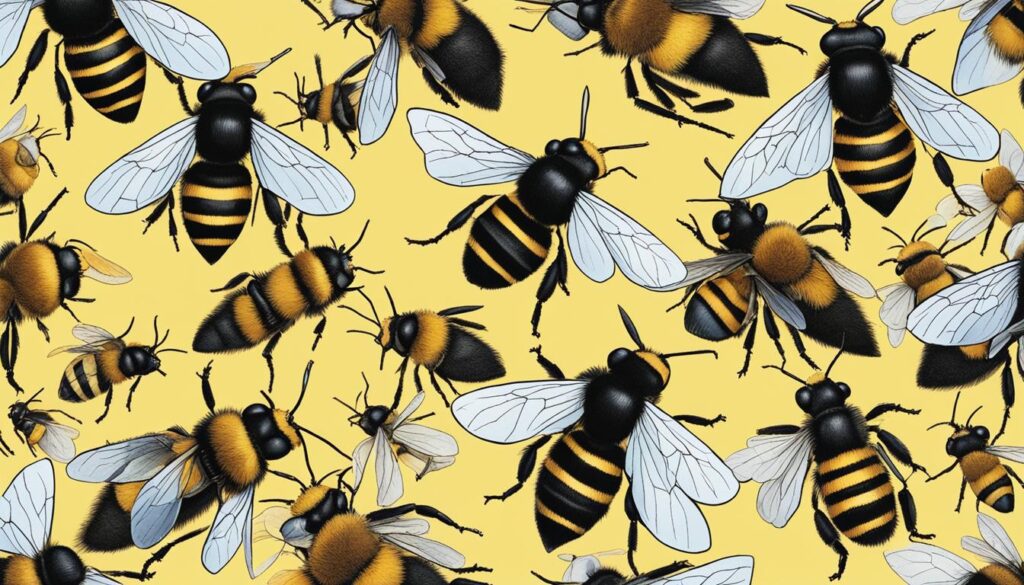Bumble bees may seem gentle and peaceful as they buzz from flower to flower, but they actually have a hidden aggressive side. These industrious insects engage in fierce battles, displaying territorial behavior and fighting with remarkable intensity. But why do bumble bees fight each other? Let’s explore the intriguing world of bumble bee aggression.
Key Takeaways:
- Bumble bees engage in a combination of flirting and fighting.
- Male bees stake out territories to attract female bees and keep other males out.
- Bumble bee aggression is also driven by competition for limited resources, such as nest sites and food.
- In some cases, worker bumble bees may become aggressive and even kill the queen to increase their own reproductive success.
- Understanding bumble bee fights provides insights into their behavior and social dynamics within the colony.
Territorial Behavior in Carpenter Bees and Bumblebees
When it comes to establishing territory, both carpenter bees and bumblebees exhibit fascinating behavior patterns. Male carpenter bees engage in aggressive displays by flying towards and shoving other males out of their claimed territory. Their main goal is to attract female bees while keeping other drones at bay. Bumblebees, on the other hand, also display territorial behavior, with male bees selecting the same locations without considering food availability or nest suitability.
This behavior seen in bumblebees is believed to assist queens in locating potential mates through scent markers. By picking the same areas, they create a sort of “meeting point” for mating opportunities. This behavior showcases the strategic nature of bumblebees when it comes to successful reproduction.
Female carpenter bees, in their pursuit of suitable nest sites, demonstrate a more assertive side. They take over the nest sites of other bees by pushing out the eggs and larvae, establishing their own dominance. This fierce competition for nesting locations highlights their determination to secure the best possible environment for their brood.
The social nature of bumblebees further adds complexity to their territorial behavior. As these bees build nests together, they often engage in territorial disputes over limited nesting sites. The competition among bumblebee colonies for these precious resources can be intense and may lead to aggressive encounters.
| Carpenter Bees | Bumblebees |
|---|---|
| Males stake out territory | Males pick same locations |
| Aggressively fly towards and shove other males | No regard for food availability or nest suitability |
| Seek to attract female bees and keep out other drones | Possibly aid queens in locating potential mates |
| Female bees take over nest sites of other bees | Build nests together and engage in territorial disputes |
Taking a closer look at the territorial behavior of both carpenter bees and bumblebees provides valuable insights into their evolutionary adaptations and social dynamics. Understanding the competition and strategies employed by these remarkable insects helps shed light on their role in maintaining the delicate balance of our ecosystems.

Conflict Within Bumblebee Colonies
Conflicts are a natural part of bumblebee colonies, arising from various factors such as competition for nest sites, invasions by cuckoo bees, and worker aggression. These conflicts play a significant role in the dynamics and survival of the colony.
When newly emerged bumblebee queens set out to establish their own nests, intense fights often ensue over the limited available nest sites. The competition can be fierce, leading to the death of one queen while the victor claims the coveted nesting spot. This conflict demonstrates the high stakes involved in securing a suitable nesting location.
Cuckoo bees, known as social parasites, present another source of conflict within bumblebee colonies. These infiltrators invade established bumblebee nests, resulting in clashes between the resident queen and the intruder. Such confrontations can be brutal as the resident queen defends her colony from the cuckoo bees’ attempts to take over.
Worker aggression within bumblebee colonies is also a significant contributor to conflict. As the colony cycle nears its end, worker bees may experience an activation of their ovaries and engage in aggressive behavior. In some cases, the worker bees may even kill the mother queen to gain reproductive dominance and produce offspring without interference. Larger workers tend to exhibit higher levels of aggression, intensifying the conflict within the colony.
Understanding these conflicts within bumblebee colonies provides valuable insights into the complex social dynamics and survival strategies of these fascinating insects.
Bumblebee Conflict Factors:
- Competition for limited nest sites
- Invasions by cuckoo bees
- Worker aggression and competition for reproductive dominance

Conclusion
Bumble bees are known for their aggression and territorial disputes, particularly during the mating season. Male bees stake out their territory to attract females and ensure that other males stay away. They engage in intense behaviors such as dive-bombing and shoving to establish dominance and secure their mating opportunities.
In addition to males, female bees, including both carpenter and bumblebees, can also display aggression and engage in conflicts over nest sites and limited resources. Nest competition among bumblebees is a common occurrence as these social insects work together to build their nests and reproduce.
Worker bumblebees may even exhibit extreme aggression, leading to the killing of the mother queen. This behavior is driven by their desire to increase their own reproductive success. By eliminating the queen, these worker bees can produce offspring without interference.
Studying and understanding the reasons behind bumble bee fights provide valuable insights into their behavior and the intricate social dynamics within their colonies. The aggressive nature and territorial disputes observed in bumble bees are fascinating aspects of their biology that highlight their complex social structure and reproductive strategies.
FAQ
Why do bumble bees fight each other?
Bumble bees engage in fights due to various reasons such as territorial behavior, competition for limited resources, and mating purposes. Male bees stake out territory to attract females while keeping other males out. Female bees may also engage in conflict, especially when competing for nest sites or taking over existing nests.
How do male carpenter bees and bumblebees exhibit territorial behavior?
Male carpenter bees stake out territory by aggressively flying towards and shoving other males out of their claimed territory. Bumblebees also exhibit territorial behavior, with males picking the same locations without regard to food availability or nest suitability. This behavior may aid the queens in locating potential mates by scent.
What conflicts occur within bumblebee colonies?
Newly emerged bumblebee queens engage in fights over nest sites, often resulting in the death of one queen. Competition for limited sites leads to conflict between queens. Cuckoo bees may also invade bumblebee nests, leading to conflicts between the resident queen and the invader. Worker bumblebees, toward the end of the colony cycle, may become aggressive and compete over male production. They may even kill the mother queen to produce without interference.
What are the reasons behind bumble bee fights?
Bumble bees exhibit aggression and engage in territorial disputes, especially during the mating season. Male bees stake out territory to attract females while keeping other males out. Female bees may engage in conflict over nest sites and compete for limited resources. Worker bumblebees can become aggressive and even kill the queen to increase their own reproductive success. Understanding the reasons behind bumble bee fights provides insight into their behavior and social dynamics within the colony.
Do female bees engage in conflicts?
Yes, female bees, both carpenter and bumblebees, may engage in conflict, especially when competing for nest sites or taking over existing nests. Female carpenter bees take over nest sites of other bees by pushing out the eggs and larvae. Bumblebees, being social bees, build nests together and engage in territorial disputes over limited nesting sites.

